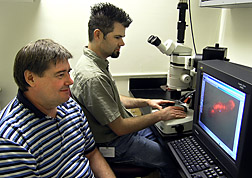This page has been archived and is being provided for reference purposes only. The page is no longer being updated, and therefore, links on the page may be invalid.
Read the magazine story to find out more. |
|
Gene "Delivery Truck" Aids Nonchemical Pest Control
By Jan SuszkiwSeptember 8, 2006
In a pest-control approach called the sterile insect technique, irradiation is used to sterilize factory-grown males of a pest insect, like screwworms or Mediterranean fruit flies. When released into the field, the males mate with wild females and no offspring are produced, thus eliminating or reducing the need for chemical insecticides.
Over the past several years, Agricultural Research Service (ARS) scientists have conducted research using molecular genetics to develop genetic systems to sterilize pest insects instead of irradiating them. This new approach calls for using modified pieces of DNA, called transposons, to introduce foreign genes that can cause sterility in pest insects.
The trick is making sure the transposons don't move after they're inserted into the insect's chromosomes. Otherwise, the sterilizing trait can be lost, notes Paul Shirk, a physiologist with ARS' Center for Medical, Agricultural and Veterinary Entomology in Gainesville, Fla.
As an alternative to using the transposons, Shirk and colleagues disabled the machinery of a virus that infects the common buckeye butterfly and turned the pathogen into a gene "delivery truck" called JcDNV. When injected into an insect's embryonic stage, the JcDNV delivers its load—a foreign gene—into a chromosome. The gene stays put, and scientists can monitor its activity throughout the insect's life, including whether it passes the gene to offspring.
However, unlike the transposons, the JcDNV restricts its deliveries to the insect's somatic (body) cells, but not its reproductive cells, notes Shirk, who's in the ARS center's Insect Behavior and Biocontrol Research Unit.
Shirk collaborated with Max Bergoin, a virologist who originally cloned the virus, Junonia coenia densovirus, at the University of Montpellier in France, and a postdoctoral team comprising Herve Bossin and Jennifer Gillett (both formerly ARS), and ARS technician Richard Furlong.
Read more about their work in the September issue of Agricultural Research magazine.
ARS is the U.S. Department of Agriculture's chief scientific research agency.

